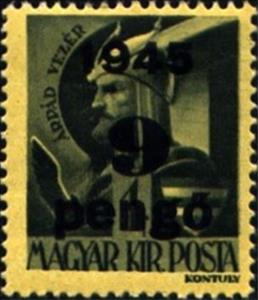Stamp: Ruling Prince Árpád (c. 850-907) (Hungary 1945)
Ruling Prince Árpád (c. 850-907) (Hungary 1945)
18 July (Hungary ) within release Surcharged goes into circulation Stamp Ruling Prince Árpád (c. 850-907) face value 9 Hungarian pengő
| Stamp Ruling Prince Árpád (c. 850-907) in catalogues | |
|---|---|
| Michel: | Mi:HU 813 |
Stamp is vertical format.
Wmk. 10. Overprint on Mi. HU705Also in the issue Surcharged:
- Stamp - Artúr Görgey (1818-1916) Honvéd general face value 1.60;
- Stamp - János Hunyadi (1385-1456) face value 2;
- Stamp - Dorottya Kanizsai (-1531) heroin face value 3;
- Stamp - Crown of St. Stephen face value 4;
- Stamp - Ferenc II Rákóczi (1676-1735) face value 5;
- Stamp - Crown of St. Stephen face value 6;
- Stamp - Crown of St. Stephen face value 7;
- Stamp - St. Elizabeth (1207-1231) face value 8;
- Stamp - Ruling Prince Árpád (c. 850-907) face value 9;
- Stamp - Crown of St. Stephen face value 10;
- Stamp - Erzsébet Szilágyi face value 20;
- Stamp - Count András Hadik (1710-1790) field marshal face value 40;
- Stamp - St. Margaret (1242-1270) face value 80;
- Stamp - Crown of St. Stephen face value 1;
Stamp Ruling Prince Árpád (c. 850-907) it reflects the thematic directions:
A head of state (or chief of state) is the public persona that officially represents the national unity and legitimacy of a sovereign state. In some countries, the head of state is a ceremonial figurehead with limited or no executive power, while in others, the head of state is also the head of government. In countries with parliamentary governments, the head of state is typically a ceremonial figurehead that does not actually guide day-to-day government activities and may not be empowered to exercise any kind of secular political authority (e.g., Queen Elizabeth II as Head of the Commonwealth). In countries where the head of state is also the head of government, the president serves as both a public figurehead and the actual highest ranking political leader who oversees the executive branch (e.g., the President of the United States).
A prince is a male ruler (ranked below a king, grand prince, and grand duke) or a male member of a monarch's or former monarch's family. Prince is also a title of nobility (often highest), often hereditary, in some European states. The female equivalent is a princess. The English word derives, via the French word prince, from the Latin noun prīnceps, from primus (first) and caput (head), meaning "the first, foremost, the chief, most distinguished, noble ruler, prince"


